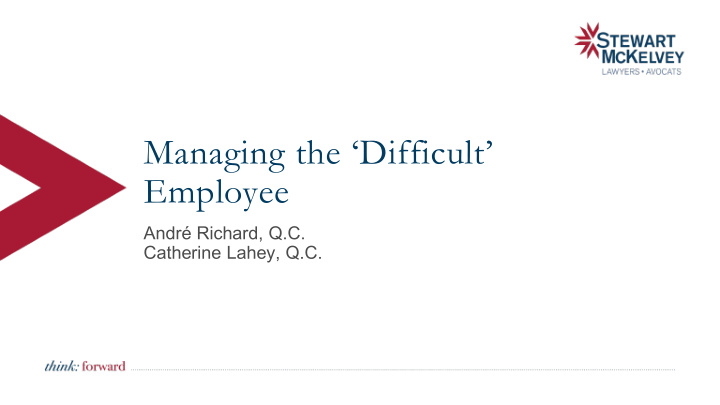



Managing the ‘Difficult’ Employee André Richard, Q.C. Catherine Lahey, Q.C.
What is a difficult employee? 2
Why bother managing your difficult employees? Liability Turnover Claims for Consider both the harassment and direct and the indirect bullying on the rise . costs Productivity Difficult employees drag Morale overall performance down . The impact upon your overall staff is PR significant . If it goes wrong – can go really wrong. 3
CRANKY EMPLOYEE Employee tells co-worker – I hope you have a horrible Christmas! THE DECISION The Grievor did not apologize. Her comments amounted to Alberta verbal abuse. Written warning Health upheld. Services LESSONS LEARNED The Employer conducted a fair and impartial investigation and concluded that a measured response was required. The Employer stuck to their guns and pushed forward to arbitration. 4
THE BULLY Grievor calls fellow employees “bitch”; 17 co -workers refuses shifts with her. THE DECISION The grievor engaged in a pattern of verbal harassment. Her repeated behavior and failure to apologize Extendicare justified termination. LESSONS LEARNED The Employer disciplined the employee on 3 prior occasions, appropriately encouraged employees to make complaints and conducted a through and impartial investigation. 5
THE ABSENTEE EMPLOYEE Employee misses 35% of time between 2010-2013 THE DECISION The Arbitrator found that the absences were excessive, the employee has been warned and there was no expectation for Barletto Bartolotta improvement . LESSONS LEARNED This employee was consistent. Communication was clear. Finally the employer easily presented that past and future attendance did not meet the required standard. 6
POOR PERFORMER QA Tester with sick child was unable to meet performance standards. THE DECISION Termination for just cause upheld. Employee failed to meet clear, reasonable standard. No ulterior motive Spielo existed. LESSONS LEARNED Patience and making the hard decision. The employer set a reasonable standard and continued to enforce that standard. 7
Be aware Listen and document Understand the employee’s Make sure you know what is 02 06 happening with your perspective. Write it all Don’t judge. employees. 01 Be aware. down. Don’t judge 03 At least at the beginning… Clear direction Identify the Make the concerns. hard Provide specific concrete 07 decision. goals. 09 Identify concerns Best Identify the behavior that is 04 concerning and why. Plan your Follow up. Practices discussion. Follow up Good or bad. Plan 08 What are you going to say? 08 How will employee react? Provide Communicate clear concerns . direction. 05 Listen and Communicate concerns Make the hard decision document. Identify the behavior that you Give the employee a 09 07 want to discuss. reasonable opportunity to 06 improve, but don’t wait to terminate. 8
02 Don’t judge. 01 Be aware . 03 Identify the Make the concerns. hard decision. 09 Best 04 Plan your Follow up. discussion. Practices Be aware. 08 Know what is Provide Communicate clear concerns . direction. happening with your 05 Listen and document. employees 07 06 9
02 Don’t 01 Be Aware. judge . 03 Identify the Make the concerns. hard decision. 09 Best 04 Plan your Follow up. Practices discussion. Don’t judge. 08 Investigate – find out Provide Communicate concerns. clear direction. what is really going 05 Listen and document on. 07 06 10
02 Don’t judge. 01 Be aware. 03 Identify Make the hard the decision. concerns 09 . Best 04 Plan your Follow up. Practices discussion. Identify the concerns. 08 Analyze – what is the Provide Communicate clear concerns . direction. problem behavior. 05 Listen and document. 07 06 11
02 Don’t judge. 01 Be aware. 03 Identify the Make the concerns. hard decision. 09 Best 04 Follow up. Plan your Practices discussion Plan your discussion. 08 Know what you are going Provide Communicate clear concerns . to say but think about how direction. Listen and 05 document. your employee might respond. 07 06 12
02 Don’t judge. 01 Be aware. 03 Identify the Make the concerns. hard decision. 09 Best 04 Plan your Follow up. Practices discussion. Communicate concerns. 08 Tell the employee about Provide Communicate clear concerns. direction. the behavior and what 05 Listen and document. needs to improve. 07 06 13
02 Don’t judge. 01 Be aware. 03 Identify the Make the concerns. hard decision. 09 Best 04 Plan your Follow up. Practices discussion. Listen and document. Understand what the 08 Provide Communicate employee is saying. clear concerns. direction. 05 Listen Keep a record about the and conversation. 07 document 06 . 14
02 Don’t judge. 01 Be aware. 03 Identify the Make the concerns. hard decision. 09 Best 04 Plan your Follow up. Practices discussion. Provide clear direction. 08 The Employee needs Provide Communicate concerns . clear to know exactly what 05 Listen and direction. document. to do to improve. 07 06 15
02 Don’t judge. 01 Be aware. 03 Identify the Make the concerns. hard decision. 09 Best 04 Plan your Follow Practices discussion. up. Follow up. 08 Good or bad, let the employee Provide Communicate clear concerns . direction. know how they fared. 05 Listen and document. 07 06 16
02 Don’t judge. 01 Be aware. 03 Identify the Make the concerns. hard 09 decision. Best 04 Practices Plan your Follow up. discussion. Make the hard decision. 08 Sometimes relationships Communicate Provide concerns. clear don’t work – figure it out direction. 05 Listen and document. early and act. 07 06 17
The most important step! 18
Questions? 19
Thank you!
21
Recommend
More recommend